The 44th Year of Monterey Jazz
| The 44th Year of Monterey Jazz |
| Jim Merod |
| 1 October 2001 |
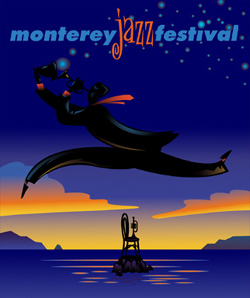
Terrorist assaults preceding this year’s jazz festival in picturesque Monterey did not blight the spirit of this venerable annual gathering. In fact, the 44th version of the WorldCom-sponsored event was extraordinary and uplifting.
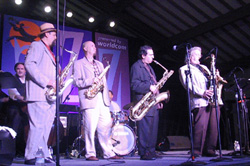 Highlights were plentiful. Joe Lovano’s Nonet opened Friday night on the Main Arena stage with Tadd Dameron’s “On A Misty Night.” The band’s crack rhythm section — John Hicks, piano, Dennis Irwin, bass, and Lewis Nash, drums — anchored the set and gave each of the group’s soloists both provocation and room to maneuver.
Highlights were plentiful. Joe Lovano’s Nonet opened Friday night on the Main Arena stage with Tadd Dameron’s “On A Misty Night.” The band’s crack rhythm section — John Hicks, piano, Dennis Irwin, bass, and Lewis Nash, drums — anchored the set and gave each of the group’s soloists both provocation and room to maneuver.
Alto saxophonist Steve Slagle, a veteran of the weekly Mingus assemblage at Fez in New York, and baritone sax man Gary Smulyan, a mainstay in various iterations of the Village Vanguard orchestra, were strong in the outdoor venue and later that night at Dizzy’s Den, where (true to form) tenor sax powerhouse Ralph Lalama got everyone’s undivided attention when he stepped forward to solo. Adding to the loose but churning musical force throughout, trumpeter Barry Reis joined trombonist Conrad Herwig and provocateur Lovano in ad hoc call and response ensemble work that set off the sax section. John Hicks’ enormous command was in evidence at every point . . . as was Lovano’s musical authority and the unbridled enthusiasm of a nine-piece band that came to the West Coast to assert the need, and healing power, of such undamped cheer.
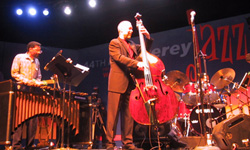 Saturday night, at Dizzy’s Den, bassist Dave Holland’s Quintet demonstrated deep if, also, intense musical magic. Their bravura work included compositions by saxophonist Chris Potter and by trombonist Robin Eubanks. Both men write music of considerable complexity. Not a problem. Holland’s crack quintet combines almost unbearable rhythmic force alongside improvisational daring and musical sensitivity.
Saturday night, at Dizzy’s Den, bassist Dave Holland’s Quintet demonstrated deep if, also, intense musical magic. Their bravura work included compositions by saxophonist Chris Potter and by trombonist Robin Eubanks. Both men write music of considerable complexity. Not a problem. Holland’s crack quintet combines almost unbearable rhythmic force alongside improvisational daring and musical sensitivity.
At the heart of the band’s fire-power is the delicate but ferocious interaction between Holland and drummer Billy Kilson . . . whose rare and beautifully musical percussion solo, midway through the set, left most in the packed house agog. Few groups in jazz today can match this one.
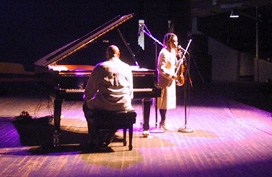 One of them, small but mighty, is the duo of violinist Regina Carter and pianist Kenny Barron. One is struck by the conversational quality of their give-and-take. Nothing is forced. At no point does either musician seem taxed for ideas. Regardless of song choice — the chestnut “Squatty Roo” (on the Main Stage) or Barron’s adventurous “What If” (in Dizzy’s Den) — the duo is as flawless as world-class skaters executing brilliant, difficult maneuvers. Bravado is not what drives their interaction. Each yields to the music as if to honor its hidden possibilities of musical meaning. If any other subtext is at work, it is Barron’s subtle support of Ms. Carter’s darting, daring, seductive, often surprising musicianship. The Carter-Barron pairing proves, with each breath it takes, that large and lasting musical statements can be made by the smallest possible musical group.
One of them, small but mighty, is the duo of violinist Regina Carter and pianist Kenny Barron. One is struck by the conversational quality of their give-and-take. Nothing is forced. At no point does either musician seem taxed for ideas. Regardless of song choice — the chestnut “Squatty Roo” (on the Main Stage) or Barron’s adventurous “What If” (in Dizzy’s Den) — the duo is as flawless as world-class skaters executing brilliant, difficult maneuvers. Bravado is not what drives their interaction. Each yields to the music as if to honor its hidden possibilities of musical meaning. If any other subtext is at work, it is Barron’s subtle support of Ms. Carter’s darting, daring, seductive, often surprising musicianship. The Carter-Barron pairing proves, with each breath it takes, that large and lasting musical statements can be made by the smallest possible musical group.
In a distinctly nostalgic vein, the Baritone Sax Summit, Saturday night in the NightClub, brought together five magnificent veterans of the big horn for three full sets. Jack Nimitz’s playing was in good form and his verbal homage to baritone sax legends Harry Carney, Serge Chaloff, Pepper Adams, Gerry Mulligan, and Cecil Payne was both heartfelt and informative. The irrepressible baritone sax master Joe Temperly provided constant musical delight.
The group’s ensemble work on Woody Herman’s “Four Brothers” roused a full house. Bill Perkins was his usual understated but joyful self. And Howard Johnson, known as much for his work on tuba as on the baritone, helped keep everyone happily focused. Drummer Joe LaBarbera, pianist Bill Cunliffe, and bassist Darek Oles kept everything in the pocket. As a sidebar, the spirit of baritone saxophonist Nick Brignola, an unstated member of the honored group, was evident in Temperly’s playing and commentary across the long weekend.
Several vocalists held forth on various stages: much-acclaimed newcomer Jane Monheit; veteran Ann Dyer; the stage-savvy Jenna Mammina; and Luciana Souza (with the Danilo Perez group). Claudia Acuna, whose empathy with her partners is uncanny, fronted a quintet that sparkled like a well-cut gem.
Acuna’s group expresses itself as a single voice. This does not mean that Acuna — who has a beautiful vocal instrument with marvelous expressiveness — does not emerge fully on her own. She does, but the exquisite blending of the group’s individual viewpoints is never sacrificed to the needs of “stardom” or personal mannerisms.
Without knowing it, Acuna at moments invokes June Christy. She is always, nonetheless, herself without a hint of self-consciousness. Bassist Dwayne Burno is just the right player here. He lifted and massaged pianist Jason Linder’s explorations. Drummer Eric McPherson added unobtrusive percussive strength. Trombonist Ari Liebovich, an exact instrumental complement to Acuna’s tender art, seems to provide the soft, persuasive touch that makes the unit cohere so well. This is a wonderful quintet.
Another exotic singer worth considerable attention is Claudia Villela, a replacement at Dizzy’s Den for Patricia Barber. Villela makes genuine demands of her audience. She refuses to offer a conventional set of music . . . as if she does not want her audience to disconnect from her vocal dexterity. Instead, she digs into her South American Songbook and extracts dozens of reasons to demonstrate amazing lyrical facility. There are few singers with Villela’s tonal pitch control. There may be fewer with her barely subdued emotional fervor. In the spare company of guitarist Ricardo Peixoto, Villela’s set provided stark contrast to any form of sadness, ennui, or bombast. As she sang, the world’s recent horror and lingering gloom disappeared. Her Friday night set was an exercise in individual artistry of a brilliant, potentially taxing, but unforgettable sort.
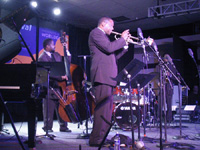 Sunday night, Wynton Marsalis was in the middle of the action with his Lincoln Center Jazz Orchestra, a collection of fifteen strong players who went at a mostly-Ellington program (in Dizzy’s Den) as if Duke was in the house to enjoy the scrimmage. Veteran Joe Temperly holds down the orchestra’s baritone chair. Probably no one on the scene today so embodies the legacy that Ellington’s closest sidekick, Harry Carney, left behind. Trumpeters Ryan Kisor and Marcus Printup each roused the spillover crowd, as did Marsalis whose growls and guttural flurries added spice to a band that purrs like a high performance engine.
Sunday night, Wynton Marsalis was in the middle of the action with his Lincoln Center Jazz Orchestra, a collection of fifteen strong players who went at a mostly-Ellington program (in Dizzy’s Den) as if Duke was in the house to enjoy the scrimmage. Veteran Joe Temperly holds down the orchestra’s baritone chair. Probably no one on the scene today so embodies the legacy that Ellington’s closest sidekick, Harry Carney, left behind. Trumpeters Ryan Kisor and Marcus Printup each roused the spillover crowd, as did Marsalis whose growls and guttural flurries added spice to a band that purrs like a high performance engine.
Two of the orchestra’s young veterans, alto saxophonists Wess Anderson and Ted Nash, are genuine stars in their own right. That fact was in evidence later, over in the NightClub, at a Miles Davis-John Coltrane jam session that featured various instrumental combinations drawn from the Lincoln Center Orchestra. Coltrane’s “Ole” received Eric Dolphy-like voicing from reedman Victor Goines. Wynton’s homage to Miles began with “Phrancing” and ended with a Davis-inspired blues. In between, he offered “Oleo” and Wayne Shorter’s enticing “Footprints.” Without stint, but with unmistakable enthusiasm, Wynton demonstrated chops and deepening musical maturity. The full house did not want him to leave the stage.
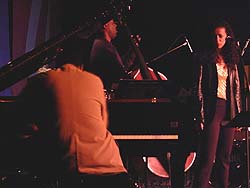 Pianist Danilo Perez brought his five member “Motherlode Project” to the last set Sunday on the stage at Dizzy’s Den. The musicians assembled quietly, with evident glee. They left a throng of listeners screaming for more even after a banner-waving, celebratory encore. Perez not only plays the keyboard with expansive, sometimes dissonant harmonic textures. His Cecil Tayloresque attempts to reinvent the piano’s tonal and percussive range add force and dynamic nuance to the group’s high-powered work. In bassist Essiett Essiett and drummer Adam Cruz, Perez has sympathetic musical explorers. Vocalist Luciana Souza adds striking, sometimes ethereal reinforcement to the group’s take-no-prisoners outlook. As ever, rising saxophone star Donny McCaslin provided enormous lyrical range. McCaslin is one of the most engaging young tenor players on the present scene. He owns an utterly distinct musical voice. Whatever (wherever) the “mother lode” is, Danilo Perez’s energetic quintet has tapped it.
Pianist Danilo Perez brought his five member “Motherlode Project” to the last set Sunday on the stage at Dizzy’s Den. The musicians assembled quietly, with evident glee. They left a throng of listeners screaming for more even after a banner-waving, celebratory encore. Perez not only plays the keyboard with expansive, sometimes dissonant harmonic textures. His Cecil Tayloresque attempts to reinvent the piano’s tonal and percussive range add force and dynamic nuance to the group’s high-powered work. In bassist Essiett Essiett and drummer Adam Cruz, Perez has sympathetic musical explorers. Vocalist Luciana Souza adds striking, sometimes ethereal reinforcement to the group’s take-no-prisoners outlook. As ever, rising saxophone star Donny McCaslin provided enormous lyrical range. McCaslin is one of the most engaging young tenor players on the present scene. He owns an utterly distinct musical voice. Whatever (wherever) the “mother lode” is, Danilo Perez’s energetic quintet has tapped it.
Trumpet master Allen Smith, long-praised by many well-informed musicians (including Ella Fitzgerald), joined saxophonist Hal Stein, guitarist Randy Vincent, and bassist Chris Amberger in a set that kept legendary drummer Benny Barth on the chilly late Sunday afternoon Garden Stage. In the previous set, Barth — who played at the initial Monterey Jazz Festival as a member of the Mastersounds — added thirteen-year old guitar prodigy Julian Lage to his trio. Lage had recently returned from work with vibist Gary Burton on the big ocean liner, the QE II. From the opening of Wes Montgomery’s “SOS,” you knew that young Mister Lage is not an ordinary kid. His command of the guitar is so far beyond his slender years that he not only pleased his audience; he awed them.
The Saturday afternoon blues bash on the outdoor Garden Stage featured a rambunctious set by Mike Schermer’s “Harmonica Blow Out” and a crowd-pleasing outing, complete with encore, by blues guitarist/vocalist Deborah Coleman. Friday evening, on the same stage, the Monterey debut of vocalist Roberta Gambarini was backed by jazz all stars George Mraz, bass, Roy Hargrove, trumpet, and Willie Jones III, drums.
A vital aspect of the Monterey Jazz Festival is the opportunity for thought-provoking colloquy at various locations across the weekend. Dan Ouellette’s “blind fold” test with composer/ arranger/historian Gunther Schuller demonstrated how wide-ranging and deep Schuller’s knowledge is . . . knowledge brought forth with tact and considerable wit. The unnamed topic was “Third Stream Music,” but Schuller’s insight extended beyond those borders.
No less impressive was the discussion that took place early Sunday morning, in the Artists’ Bar, between legendary photographer Herman Leonard and two dozen of his professional colleagues, including Ray Avery, Michael Oletta, Janna Gadden, Edie Ellis, and Will Wallace. Bassist extraordinaire Ray Drummond joined the conversation. Later that day, the nearly octogenarian Leonard — who mounted a group of his most well-known photos in the Coffee House Gallery (including a riotous 1949 shot of James Moody and a series of Miles Davis taken over a forty year period) — held forth with stylish good humor in the Night Club. The presentation was one for the ages. With under-stated ease, Leonard added personal and technical footnotes to a narrative that framed stunning shots of Art Tatum, Johnny Hodges, Charlie Parker, Lena Horne, George Shearing, Billie Holiday, Sarah Vaughan, Ella Fitzgerald, Al Grey, and many more.
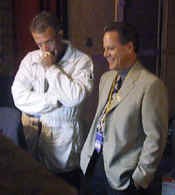 Hats off to a smiling Tim Jackson (right), who packs so much stunning music into two and one-half days; to Paul Fingerote who keeps the press and media well-functioning in their efforts to cover events; and to the efficient crews, all across the large Monterey fairgrounds, who construct (and reconstruct) audio and physical stage sets that keep musicians and listeners happily in a musical groove.
Hats off to a smiling Tim Jackson (right), who packs so much stunning music into two and one-half days; to Paul Fingerote who keeps the press and media well-functioning in their efforts to cover events; and to the efficient crews, all across the large Monterey fairgrounds, who construct (and reconstruct) audio and physical stage sets that keep musicians and listeners happily in a musical groove.
Photos taken by Robert Holt and Wayne Saroyan ofJazzwest.com
![]()
Don’t forget to bookmark us! (CTRL-D)
Stereo Times Masthead
Publisher/Founder
Clement Perry
Editor
Dave Thomas
Senior Editors
Frank Alles, Mike Girardi, Key Kim, Russell Lichter, Terry London, Moreno Mitchell, Paul Szabady, Bill Wells, Mike Wright, Stephen Yan, and Rob Dockery
Current Contributors
David Abramson, Tim Barrall, Dave Allison, Ron Cook, Lewis Dardick, Dan Secula, Don Shaulis, Greg Simmons, Eric Teh, Greg Voth, Richard Willie, Ed Van Winkle, and Rob Dockery
Music Reviewers:
Carlos Sanchez, John Jonczyk, John Sprung and Russell Lichter
Site Management Clement Perry
Ad Designer: Martin Perry




Be the first to comment on: The 44th Year of Monterey Jazz